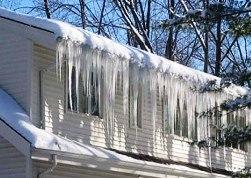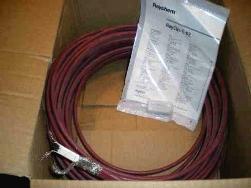Categories: Featured Articles » Interesting electrical news
Number of views: 11965
Comments on the article: 1
Roof anti-icing system
 How to protect icing roof
How to protect icing roof
The accumulation of snow and ice on the roof of the house negatively affects the roof - the load on the roof frame increases and its service life is reduced.
As practice shows, almost all spring drops from the ceiling of the room are not caused by damage to the integrity of the roof, but because of the snow, which formed an ice block on the roof.
In the modern world, this problem is solved very simply. It is necessary to provide a special roof anti-icing system.
Installation of the anti-icing system should be done only in problem areas where ice is constantly appearing, creating a threat of damage to the roof or collapse of snow and ice.
Installing an anti-icing system for flat roofs is slightly different from installing on a roof with a slope. On the flat roof, all external drainpipes are necessarily heated, and the roof surface is also heated around the internal drains.
On roofs with a steep slope, in addition to gutters, it is necessary to equip the system with overhangs for roofs, drainage funnels, trays and dormers. For a roof made of metal, in order to avoid the convergence of a large mass of snow from unheated sections of the roof, it is necessary to install special snow retainers.
 The anti-icing system consists of heating cable (about the same as in warm floors), temperature sensor (placed in the coldest places) and humidity sensor (installed in the wettest place on the roof).
The anti-icing system consists of heating cable (about the same as in warm floors), temperature sensor (placed in the coldest places) and humidity sensor (installed in the wettest place on the roof).
There are manual anti-icing roof systems, but they are significantly inferior in convenience to automatic ones. Automation responds more quickly to any weather fluctuations and connects and disconnects the system on time, which significantly saves electricity.
When fixing the heating cable, be careful not to damage the integrity of the roof. Rivets must be used only for gutters, in those places where this is necessary. In other cases, special fasteners, a special mounting tape, and pieces of roofing material are used. To protect the cable from breaking by overhanging ice in drainpipes and valleys, it is attached to a metal cable.
In the anti-icing system use thermal cable of two types - resistive and self-regulating. Resistive cable is cheaper and used in conjunction with an automatic regulator. They are less durable than self-regulating ones.  Self-regulating heating cable can change heat transfer in one or more local areas, depending on heat loss. Manual anti-icing system with resistive cable has a high operating cost.
Self-regulating heating cable can change heat transfer in one or more local areas, depending on heat loss. Manual anti-icing system with resistive cable has a high operating cost.
Ready-made cable sections are available for sale with a fixed-length cable segment, fastened with a sleeve to a cable that connects the cable to the electrical network. There is a thermal cable in the bays, which are used for complex architectural roofs. For standard tasks, you can use the finished thermal cable section.
In order to withstand the icing of the drainpipes, valleys and trays, the power of the heating cable is 20-60 W / m. Power depends on the diameter of the pipe and tray. A cable for the anti-icing system is produced with a power of 20-40 W / m. In the event that the power is insufficient, the thermal cable is laid in two lines.
See also at bgv.electricianexp.com
:
